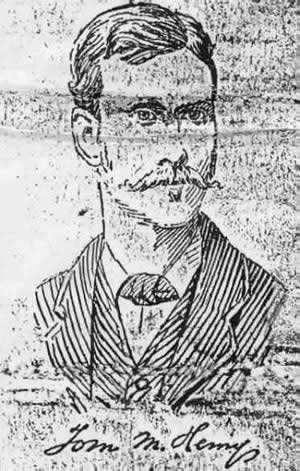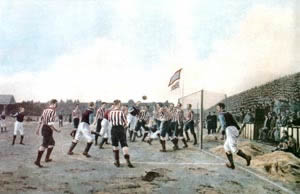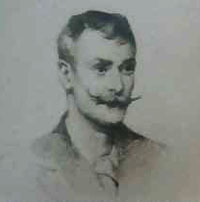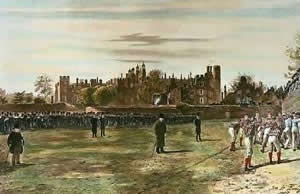
thomas marie madawaska hemy
1852 - 1937
Sunderland Painting ‘Coming Home’ Sunderland Football Club today, Monday 15th September 1997, revealed that the famous painting by Thomas M.M. Hemy (1852-1931) which has been on loan to Sunderland Museum and Art Gallery since 1990, will be returning home to the Sunderland Stadium of Light.  The painting which was completed in 1895 shows a winter match between the two leading teams of the time and is one of the earliest portrayals of Association Football in the world. At the time, Aston Villa were the reigning league champions, but Sunderland wrestled the Championship from them in 1894/95 season. Both teams were crammed with talent, Sunderland having 10 Scotsmen in its team including the balding Ted Doig, the ‘Prince of Goalkeepers’. The match was played at Sunderland’s Newcastle Road ground, the Club’s home venue from 1886, until the move to Roker Park in 1898. Twelve thousand fans and club officials, many depicted in the picture, watched a thrilling contest which finished 4 – 4. The Hemy painting will take pride of place in the main entrance at the Sunderland Stadium of Light. The marble reception area was specially designed with the painting’s return in mind. Sunderland Commercial Director, Grahame McDonnell said: " We are delighted the famous Hemy painting is back where it belongs at the home of Sunderland AFC. The painting will located in the stadium’s main entrance making a superb first impression for visitors. We would like to offer our sincere thanks to everyone involved in ensuring the painting has a safe journey home." Commenting on the return of the painting to the Football Club, Helen Gray, Communications Officer for Tyne and Wear Museums said: " Naturally, we are sad to see the painting go, but it is a very large painting and it takes up a lot of space in the gallery. We will have the opportunity to display more paintings, giving visitors the chance to see a wider range of Sunderland Museum & Art Gallery’s own collection ". The Hemy painting which was restored with the assistance of Sunderland AFC Supporters Association prior to its move to the Sunderland Museum and Art Gallery in 1990, is 96 inches in height and 104 inches in width, exclusive of the frame. With the frame the dimensions are 108.5 inches in height and 163 inches in width. The frame itself is solid wood with a mould and carved gold leaf decoration. A solid wood football appears on the front of the picture. Along the bottom of the painting is an ivory panel with the player’s names on it. ________________________ Introduction Anyone walking into the main foyer of the Stadium Of Light cant help notice the stunning painting, behind its protective glass casing, of the 1895 fixture between Sunderland and Aston Villa played at our then home ground of Newcastle Road. That the match ended 4 v 4 was fairly inconsequential, that the painting is perhaps the oldest of an Association Football match in the world, isn’t. The “Hemy Painting” as it is commonly referred to is in due deference to the artist Thomas Maria Madawaska Hemy. In celebration of Sunderland AFC’s third English league championship 1894/95 the football club commissioned Hemy, a local artist who resided in Sunderland, to paint a picture of the team in action and the game against Villa was the match chosen. The painting has over the years had 2 titles; “A Corner Kick” and “The Last Minute - Now or Never”. This is the story of the the match, the artist and the further history of this priceless footballing artefact. ________________________ The Match
This was the biggest game of the season at Newcastle Rd when current league champions Aston Villa came into town. They started badly and lost at home to Sunderland in September but since then they have gradually climbed the league ladder and are now in strong contention for the championship. Villa were confident of winning and at odds of 6 to 4 appeared a good bet. There was a great deal at stake for Sunderland who following Everton’s defeat a few days ago stood proudly at the top of the table. 
Villa arrived on Tuesday and looked in the peak of condition. The weather was fine and much warmer than Tuesday although a strong NW wind was blowing. Meehan returned at right back for Sunderland and Johnstone moved to left half with Auld dropping out. The pitch was in pretty fair condition with a lot less snow on it and the crowd of around 12,000 was bigger than that of New Years Day. Sunderland won the toss, took advantage of the wind and Devey kicked off for Villa. Sunderland were first to show and Gillespie raced away to send a hard shot just wide. Villa were very lively however and Cowan got in a shot that went a few yards wide. Sunderland came again and were pressing very strongly but Villa were not to be denied and came at Sunderland with terrific pace with Smith driving in a shot that Doig kicked away. The Sunderland defence was kept busy and Meehan was doing very well. A grand rush from Smith saw the Villa man strike the post with an absolute beauty as the visitors kept going with great dash. Sunderland at last managed to mount an attack but Spencer cleared and then a free kick to the home side was gathered right under the bar by Dunning. Dunning saved again when the home forwards made another rush. Sunderland were having a bright spell and again and again the Villa custodian stopped shots which could easily have brought goals. When Hannah did beat him his hotshot struck the post and went wide. Villas forwards were playing well and a long raking pass by Athersmith found Smith who neatly popped the ball past Doig to put Villa ahead in the 15th minute Sunderland retaliated but were soon driven back and Doig did well to save a cracking shot and keep Sunderland in the game. The home side were struggling to find their form but at last managed to work the ball into the Villa goalmouth where some neat passing set up Gillespie to shoot home the equaliser after 25 minutes. This made it a much better game and play became very exciting. Villa were playing very forcibly but they had to fall back when Hannah nipped in and fired a hard shot just wide. A spell of midfield play followed. After 30 minutes play Smith broke away and dashed past Dunlop and Meehan to let fly from long range. Doig had begun to advance and was astounded as the ball sailed over his head and dipped into the net. It was a superb shot that was worth a goal. Villa continued to buzz around the home goal and Doig was kept busy as the ball remained in the Sunderland half. In fact Doig was busier that he has been for many a long day at home and his left fist was constantly on the go. In view of the pressure that Villa were applying a 3rd goal seemed inevitable and it duly arrived when Smith sent in a fine pass. Devey raced onto the ball and was promptly flattened by Johnstone inside the penalty area to bring Villa penalty kick. Reynolds hammered the ball against the underside of the bar and into the net to put Villa 3-1 up. Sunderland rallied after this and Campbell took a pass from Hannah to crack a shot against the crossbar. Amidst great excitement Sunderland pressed again. The ball was swung into the Villa goalmouth and a fierce scrimmage took place in front of the posts. Dunning kept out one shot and when the ball was returned Hannah poked it into the net to reduce Sunderland's arrears to one. Villa were still a lively lot and were on the attack when the halftime whistle blew. Facing the wind in the 2nd half Sunderland started strongly and Gillespie was just off target with a good shot. Villa went straight to the other end and Doig saved well before sending the home forwards away again. Sunderland were very poor in front of goal and their shooting left much to be desired. Russell took a Villa free kick and dropped the ball right in front of Doig but he managed to fist clear and Hannah went racing away over the centre line. Sunderland mounted a concerted attack and play remained in Villa territory for quite some time. The Villa goal was in constant danger but the visitors defended well and kept the home forwards at bay. Athersmith raided for Villa but Reynolds fouled McCreadie and Sunderland returned to the attack. Hannah went close but Spencer got the ball away and then a free kick handed the initiative back to Sunderland. McNeill took it and found Millar who fired into the net from close range to equalise in the 70th minute. The ground erupted as hats and sticks flew into the air amidst immense excitement. Soon afterwards Russell fouled Campbell and from the free kick another scrimmage occurred in the Villa goalmouth. Players from both sides clustered around the ball and it fell to Gillespie who whipped it into the net to put Sunderland ahead for the first time. Villa retaliated strongly and applied tremendous pressure on the home goal although the attacks did not have the same sting as their earlier onslaughts. Russell put a shot over the bar and then Devey got in a grand long shot that Doig collected comfortably. The ball was moving rapidly from end to end and in one spirited attack Sunderland had hard lines in not being awarded a penalty when Campbell was deliberately fouled. Villa were soon back on the attack and bombarding the Sunderland citadel with only grand defending preventing an equaliser. As the game drew to a close the fast pace did not diminish and the excitement remained at fever pitch. Dunning made a magnificent save to keep out a long shot from McCreadie and then Villa swept the ball up the field. After a bit of neat passing Devey shot home an equaliser for Villa in the last couple of minutes and soon after a magnificent game ended in a draw. Sunderland: Doig, Meehan. McNeil, Dunlop, McCreadie, Johnstone, Gillespie (2), Millar, Campbell, Hannah (J), Scott ________________________ The Artist  Thomas Marie Madawaska Hemy was born in 1852 off the Murtar Var Rocks near the Barilian Coast in 1852. The "Marie" was in due deference to the Catholic Church of which his father was a devout member and the " Madawaska" in homage to the ship that he was born on.The ship Madewaska was registered in Canada and named after a river in Ontario. His sea birth was due to the family emigrating (temporarily) to Australia, leaving Liverpool in 1852 bound for Sydney Harbour. The family's roots were in Newcastle, where Charles Hemy (see below) had been born, and having found life tough in Melbourne, where they had settled,the family returned to the North East in 1854. At aged 14 Thomas Hemy ran away to Sea for 4 years sailing exotic seas such as The Dardanelles aboard such ships as The Brindisi, a passage of his life that he recounted in his autobiograhy Deep Sea Days.  It is perhaps then no co-incidence given all of this that Hemy's brother (Thomas had 9 brothers and 3 sisters) Charles Napier Hemy would become one of the finest British maritime painters to have lived, a talent that was to be passed on to Thomas. All the family had a love of the sea and the Arts, Hemy's Father Henri was an accomplished musician. Back In England a substantial amount of Thomas's time was spent at the mouth of the Tyne River painting boats or inspiring paintings of shipwrecks. Perhaps his most famous work being The Wreck Of The Birkenhead. However he also gave us masterpieces such as The Eton Wall Game and of course "The Last Minute - Now Or Never". However it would be wrong to think of Hemy as a parochial North East painter. We have read about his sailing exploits which gave him a very broad horizon and he also exhibited at such places as The Royal Academy in London and studied at the Antwerp Academy Of Arts for two years studying under Charles Verlat. He was often commissioned to paint and had his subsequent efforts purchased by such people as Lord Charles Beresford. Towards the end of his life Hemy left the North East and settled in St Helens on the Isle Of Wight where he died on an unknown date in 1937. ________________________ Further History It was reported in the June 1898 edition of the Sporting Mirror that: "The annual meeting of the Sunderland Football Club has been fixed for the 29th of this month. The officials have purchased the painting by Tom Henry (sic), representing the cup tie between Aston Villa and Sunderland in 1894 and also the artist's supplementary proofs. Both the painting and the proofs they propose to put up as a prize drawing for the benefit of the funds of the club". There are however a number of errors in the above report (which emphasises just how difficult piecing together the clubs history is for historians over 100 years later) in that:
Unless of course we're all wrong and the painting actually represents either the league game at Aston Villa on 15 September 1894 or the FA Cup semi final on 16 March 1895. I am led to believe from officials at the SAFC Supporters Association that a previous club Chairman bought the proofs a number of years ago when they were offered. The proofs were the artists pre sketches for the painting itself. It is not known how many were produced (thought to be over 100) or how many now survive. There are 2 ironies regarding both the painting and Hemy. The first is that on 11 July 1900 at the annual general meeting of Sunderland AFC, which took place at The Grand Hotel in the Town, it was revealed that the football club had finally got round to offering the painting as first prize in a raffle, two years after they had received it from Hemy, but no one had claimed it (not surprising given its size). It was therefore resolved to place the painting in storage at a local furniture dealers pending a decision on its future. It’s moot to ponder what might have happened if the picture had been claimed by the winning ticket holder. The second irony is the timing of Hemy’s death, in 1937, the year of course that Sunderland AFC eventually won its Holy Grail, the FA Cup. Did Hemy live to know of or even care about Sunderland winning the FA Cup or had he died before that famous day in May 1937? No one knows. However Hemy's legacy still lives on today and he died in blissful ignorance that he had depicted the oldest painting of an association football match anywhere in the world. Next time you see the painting, perhaps you might spare a moment for Hemy, who gave it to us. _____________________________
|